Quality Improvement in Health and Social Care: A Comprehensive Report
VerifiedAdded on 2023/06/04
|8
|3003
|185
Report
AI Summary
This report delves into the multifaceted aspects of quality management within the health and social care (HSC) sector. It begins by defining quality assurance and its critical role in ensuring high standards of care, encompassing assessment, correction, and monitoring of patient care aspects. The report then critically analyzes two prominent quality improvement models: the Lean model, which focuses on minimizing waste and maximizing patient value, and the Six Sigma model, which emphasizes process improvement and error reduction. Further, it examines the Care Quality Commission's role in maintaining quality through inspections and monitoring, as well as the use of benchmarks to assess performance against national standards. The report also evaluates various methods for gathering feedback, including surveys and informal interactions, and identifies key stakeholders in the quality improvement process. Finally, it assesses strategies for enhancing service user safety, such as facilitating access to electronic health records, maintaining a clean hospital environment, creating safe patient experiences, and implementing efficient appointment scheduling. The report concludes by emphasizing the importance of continuous improvement and patient-centered care in achieving optimal outcomes.
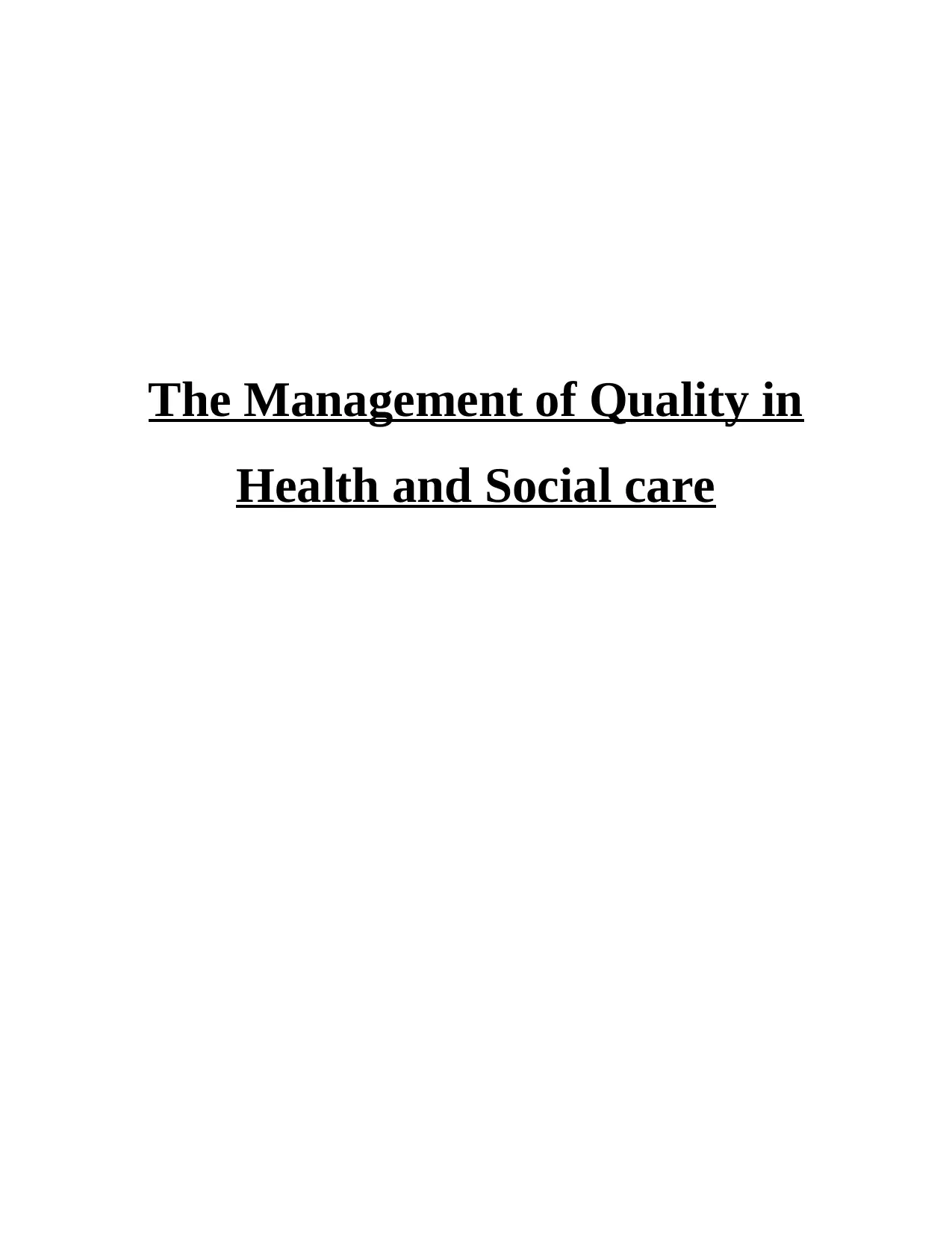
The Management of Quality in
Health and Social care
Health and Social care
Paraphrase This Document
Need a fresh take? Get an instant paraphrase of this document with our AI Paraphraser
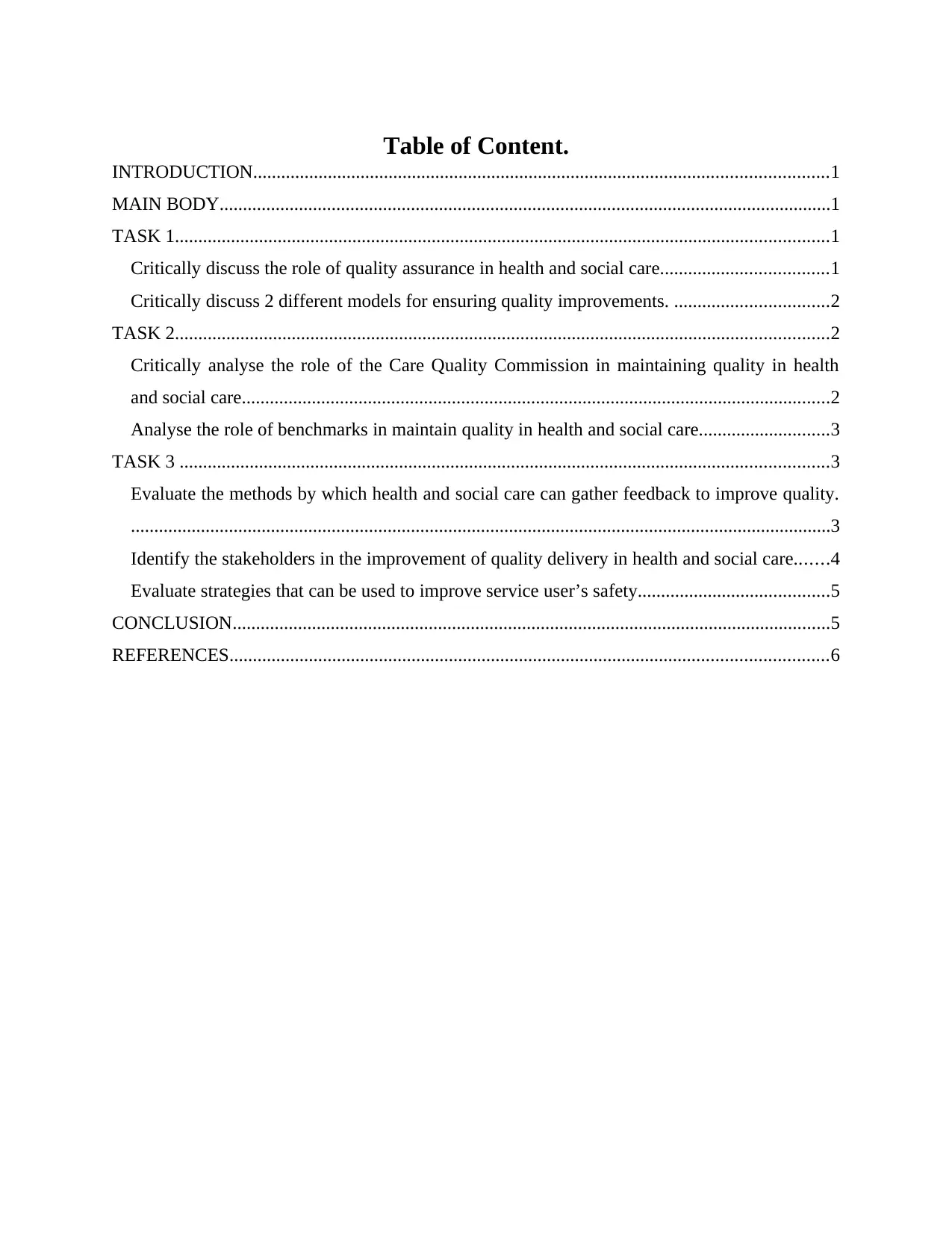
Table of Content.
INTRODUCTION...........................................................................................................................1
MAIN BODY...................................................................................................................................1
TASK 1............................................................................................................................................1
Critically discuss the role of quality assurance in health and social care....................................1
Critically discuss 2 different models for ensuring quality improvements. .................................2
TASK 2............................................................................................................................................2
Critically analyse the role of the Care Quality Commission in maintaining quality in health
and social care..............................................................................................................................2
Analyse the role of benchmarks in maintain quality in health and social care............................3
TASK 3 ...........................................................................................................................................3
Evaluate the methods by which health and social care can gather feedback to improve quality.
......................................................................................................................................................3
Identify the stakeholders in the improvement of quality delivery in health and social care.......4
Evaluate strategies that can be used to improve service user’s safety.........................................5
CONCLUSION................................................................................................................................5
REFERENCES................................................................................................................................6
INTRODUCTION...........................................................................................................................1
MAIN BODY...................................................................................................................................1
TASK 1............................................................................................................................................1
Critically discuss the role of quality assurance in health and social care....................................1
Critically discuss 2 different models for ensuring quality improvements. .................................2
TASK 2............................................................................................................................................2
Critically analyse the role of the Care Quality Commission in maintaining quality in health
and social care..............................................................................................................................2
Analyse the role of benchmarks in maintain quality in health and social care............................3
TASK 3 ...........................................................................................................................................3
Evaluate the methods by which health and social care can gather feedback to improve quality.
......................................................................................................................................................3
Identify the stakeholders in the improvement of quality delivery in health and social care.......4
Evaluate strategies that can be used to improve service user’s safety.........................................5
CONCLUSION................................................................................................................................5
REFERENCES................................................................................................................................6
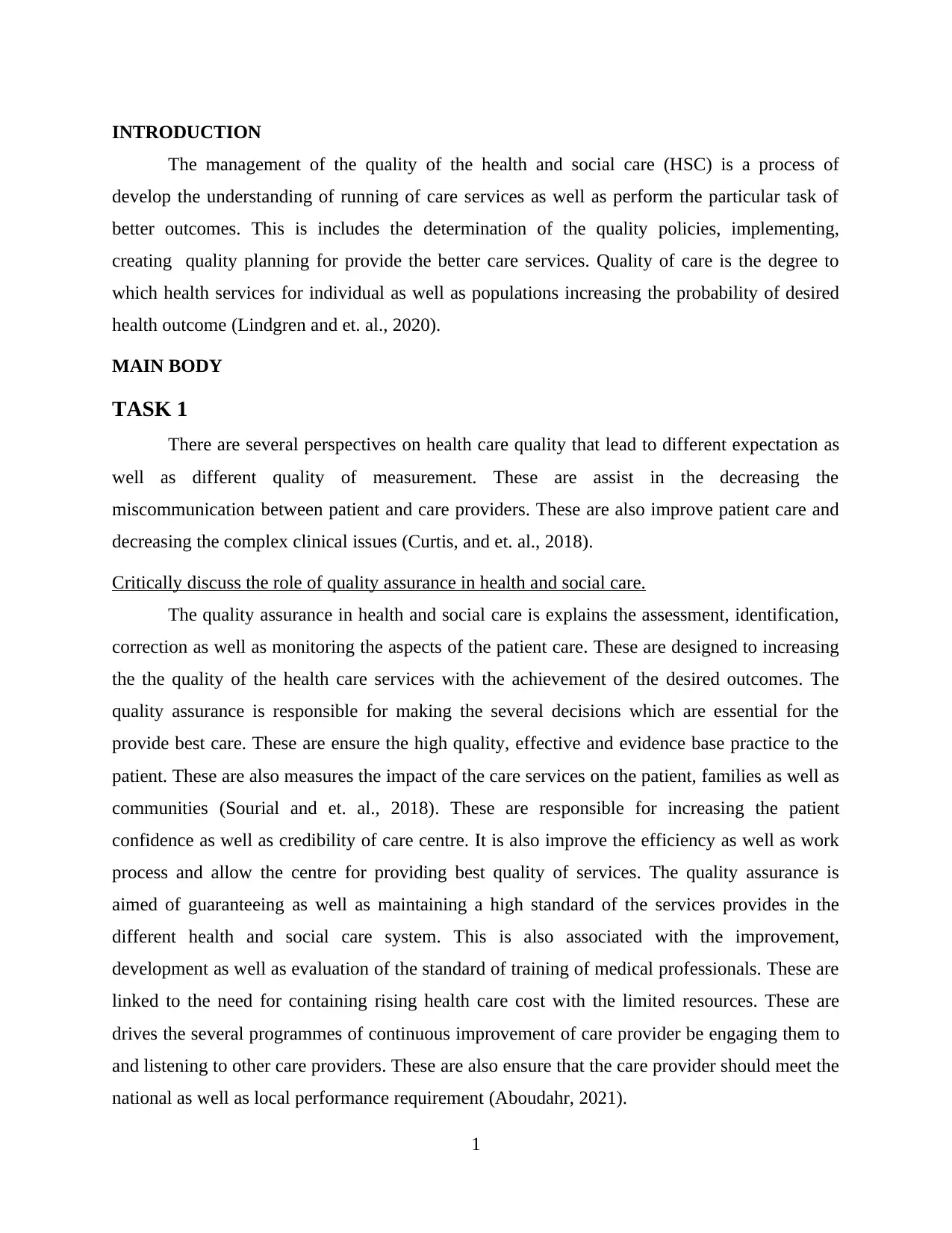
INTRODUCTION
The management of the quality of the health and social care (HSC) is a process of
develop the understanding of running of care services as well as perform the particular task of
better outcomes. This is includes the determination of the quality policies, implementing,
creating quality planning for provide the better care services. Quality of care is the degree to
which health services for individual as well as populations increasing the probability of desired
health outcome (Lindgren and et. al., 2020).
MAIN BODY
TASK 1
There are several perspectives on health care quality that lead to different expectation as
well as different quality of measurement. These are assist in the decreasing the
miscommunication between patient and care providers. These are also improve patient care and
decreasing the complex clinical issues (Curtis, and et. al., 2018).
Critically discuss the role of quality assurance in health and social care.
The quality assurance in health and social care is explains the assessment, identification,
correction as well as monitoring the aspects of the patient care. These are designed to increasing
the the quality of the health care services with the achievement of the desired outcomes. The
quality assurance is responsible for making the several decisions which are essential for the
provide best care. These are ensure the high quality, effective and evidence base practice to the
patient. These are also measures the impact of the care services on the patient, families as well as
communities (Sourial and et. al., 2018). These are responsible for increasing the patient
confidence as well as credibility of care centre. It is also improve the efficiency as well as work
process and allow the centre for providing best quality of services. The quality assurance is
aimed of guaranteeing as well as maintaining a high standard of the services provides in the
different health and social care system. This is also associated with the improvement,
development as well as evaluation of the standard of training of medical professionals. These are
linked to the need for containing rising health care cost with the limited resources. These are
drives the several programmes of continuous improvement of care provider be engaging them to
and listening to other care providers. These are also ensure that the care provider should meet the
national as well as local performance requirement (Aboudahr, 2021).
1
The management of the quality of the health and social care (HSC) is a process of
develop the understanding of running of care services as well as perform the particular task of
better outcomes. This is includes the determination of the quality policies, implementing,
creating quality planning for provide the better care services. Quality of care is the degree to
which health services for individual as well as populations increasing the probability of desired
health outcome (Lindgren and et. al., 2020).
MAIN BODY
TASK 1
There are several perspectives on health care quality that lead to different expectation as
well as different quality of measurement. These are assist in the decreasing the
miscommunication between patient and care providers. These are also improve patient care and
decreasing the complex clinical issues (Curtis, and et. al., 2018).
Critically discuss the role of quality assurance in health and social care.
The quality assurance in health and social care is explains the assessment, identification,
correction as well as monitoring the aspects of the patient care. These are designed to increasing
the the quality of the health care services with the achievement of the desired outcomes. The
quality assurance is responsible for making the several decisions which are essential for the
provide best care. These are ensure the high quality, effective and evidence base practice to the
patient. These are also measures the impact of the care services on the patient, families as well as
communities (Sourial and et. al., 2018). These are responsible for increasing the patient
confidence as well as credibility of care centre. It is also improve the efficiency as well as work
process and allow the centre for providing best quality of services. The quality assurance is
aimed of guaranteeing as well as maintaining a high standard of the services provides in the
different health and social care system. This is also associated with the improvement,
development as well as evaluation of the standard of training of medical professionals. These are
linked to the need for containing rising health care cost with the limited resources. These are
drives the several programmes of continuous improvement of care provider be engaging them to
and listening to other care providers. These are also ensure that the care provider should meet the
national as well as local performance requirement (Aboudahr, 2021).
1
⊘ This is a preview!⊘
Do you want full access?
Subscribe today to unlock all pages.

Trusted by 1+ million students worldwide
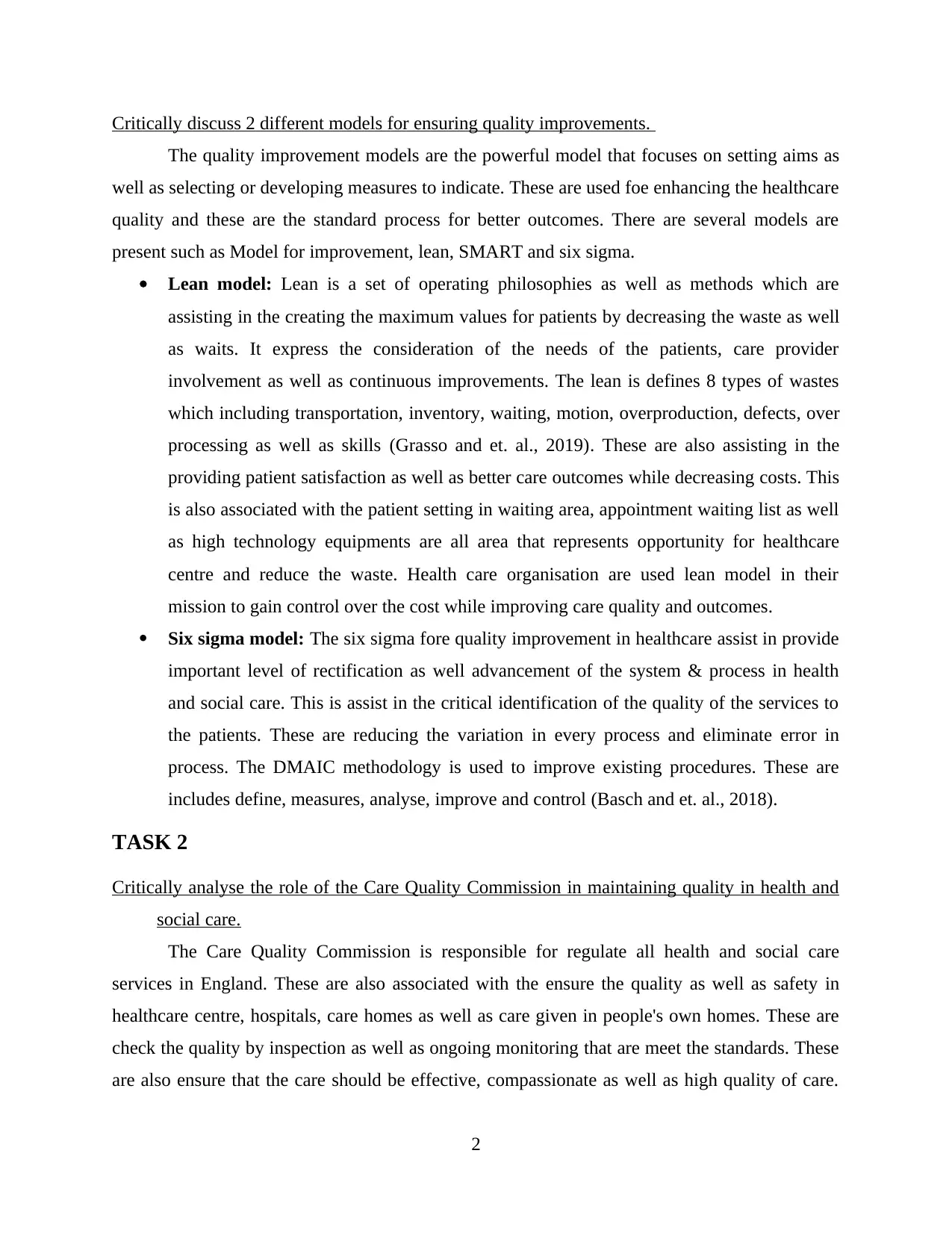
Critically discuss 2 different models for ensuring quality improvements.
The quality improvement models are the powerful model that focuses on setting aims as
well as selecting or developing measures to indicate. These are used foe enhancing the healthcare
quality and these are the standard process for better outcomes. There are several models are
present such as Model for improvement, lean, SMART and six sigma.
Lean model: Lean is a set of operating philosophies as well as methods which are
assisting in the creating the maximum values for patients by decreasing the waste as well
as waits. It express the consideration of the needs of the patients, care provider
involvement as well as continuous improvements. The lean is defines 8 types of wastes
which including transportation, inventory, waiting, motion, overproduction, defects, over
processing as well as skills (Grasso and et. al., 2019). These are also assisting in the
providing patient satisfaction as well as better care outcomes while decreasing costs. This
is also associated with the patient setting in waiting area, appointment waiting list as well
as high technology equipments are all area that represents opportunity for healthcare
centre and reduce the waste. Health care organisation are used lean model in their
mission to gain control over the cost while improving care quality and outcomes.
Six sigma model: The six sigma fore quality improvement in healthcare assist in provide
important level of rectification as well advancement of the system & process in health
and social care. This is assist in the critical identification of the quality of the services to
the patients. These are reducing the variation in every process and eliminate error in
process. The DMAIC methodology is used to improve existing procedures. These are
includes define, measures, analyse, improve and control (Basch and et. al., 2018).
TASK 2
Critically analyse the role of the Care Quality Commission in maintaining quality in health and
social care.
The Care Quality Commission is responsible for regulate all health and social care
services in England. These are also associated with the ensure the quality as well as safety in
healthcare centre, hospitals, care homes as well as care given in people's own homes. These are
check the quality by inspection as well as ongoing monitoring that are meet the standards. These
are also ensure that the care should be effective, compassionate as well as high quality of care.
2
The quality improvement models are the powerful model that focuses on setting aims as
well as selecting or developing measures to indicate. These are used foe enhancing the healthcare
quality and these are the standard process for better outcomes. There are several models are
present such as Model for improvement, lean, SMART and six sigma.
Lean model: Lean is a set of operating philosophies as well as methods which are
assisting in the creating the maximum values for patients by decreasing the waste as well
as waits. It express the consideration of the needs of the patients, care provider
involvement as well as continuous improvements. The lean is defines 8 types of wastes
which including transportation, inventory, waiting, motion, overproduction, defects, over
processing as well as skills (Grasso and et. al., 2019). These are also assisting in the
providing patient satisfaction as well as better care outcomes while decreasing costs. This
is also associated with the patient setting in waiting area, appointment waiting list as well
as high technology equipments are all area that represents opportunity for healthcare
centre and reduce the waste. Health care organisation are used lean model in their
mission to gain control over the cost while improving care quality and outcomes.
Six sigma model: The six sigma fore quality improvement in healthcare assist in provide
important level of rectification as well advancement of the system & process in health
and social care. This is assist in the critical identification of the quality of the services to
the patients. These are reducing the variation in every process and eliminate error in
process. The DMAIC methodology is used to improve existing procedures. These are
includes define, measures, analyse, improve and control (Basch and et. al., 2018).
TASK 2
Critically analyse the role of the Care Quality Commission in maintaining quality in health and
social care.
The Care Quality Commission is responsible for regulate all health and social care
services in England. These are also associated with the ensure the quality as well as safety in
healthcare centre, hospitals, care homes as well as care given in people's own homes. These are
check the quality by inspection as well as ongoing monitoring that are meet the standards. These
are also ensure that the care should be effective, compassionate as well as high quality of care.
2
Paraphrase This Document
Need a fresh take? Get an instant paraphrase of this document with our AI Paraphraser
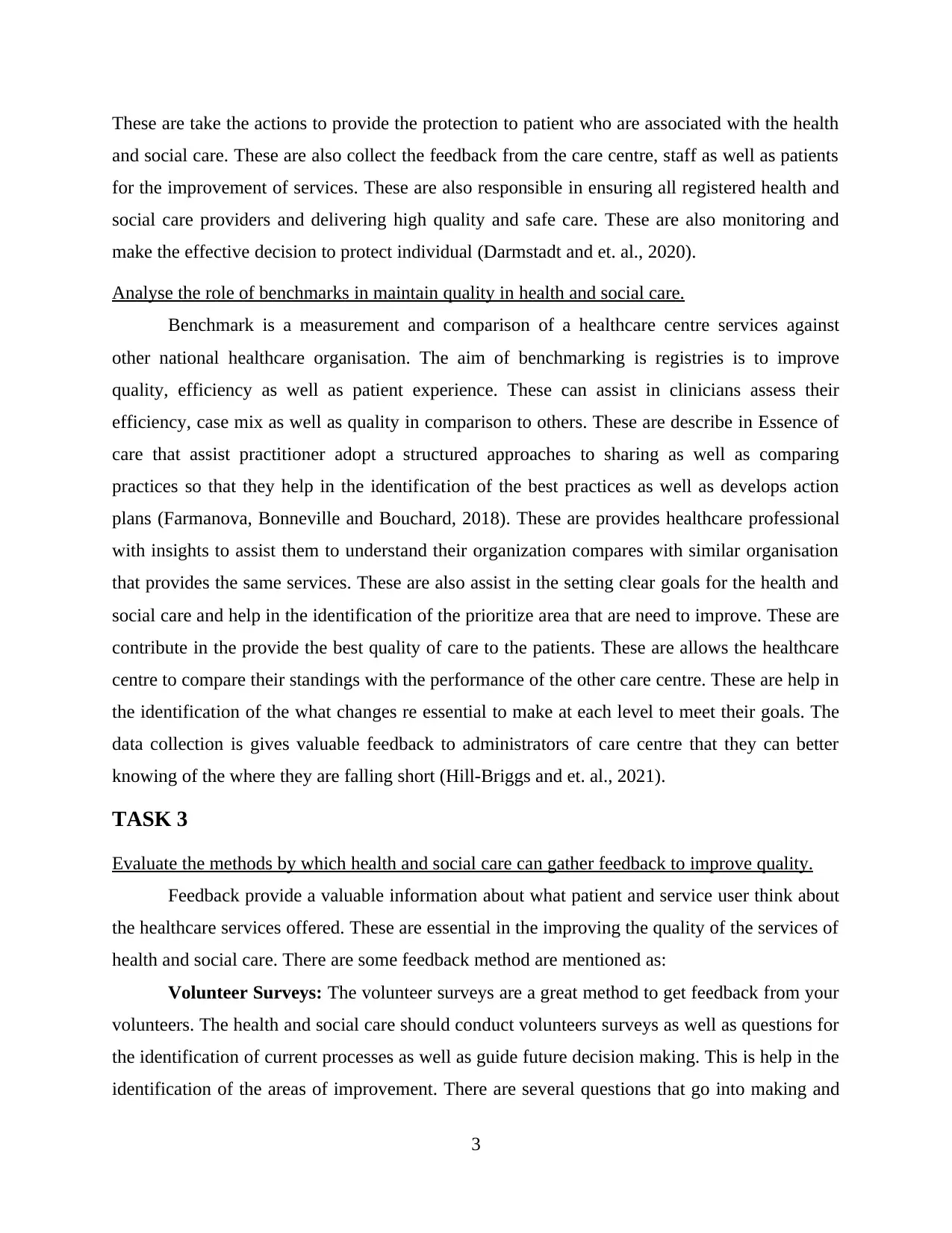
These are take the actions to provide the protection to patient who are associated with the health
and social care. These are also collect the feedback from the care centre, staff as well as patients
for the improvement of services. These are also responsible in ensuring all registered health and
social care providers and delivering high quality and safe care. These are also monitoring and
make the effective decision to protect individual (Darmstadt and et. al., 2020).
Analyse the role of benchmarks in maintain quality in health and social care.
Benchmark is a measurement and comparison of a healthcare centre services against
other national healthcare organisation. The aim of benchmarking is registries is to improve
quality, efficiency as well as patient experience. These can assist in clinicians assess their
efficiency, case mix as well as quality in comparison to others. These are describe in Essence of
care that assist practitioner adopt a structured approaches to sharing as well as comparing
practices so that they help in the identification of the best practices as well as develops action
plans (Farmanova, Bonneville and Bouchard, 2018). These are provides healthcare professional
with insights to assist them to understand their organization compares with similar organisation
that provides the same services. These are also assist in the setting clear goals for the health and
social care and help in the identification of the prioritize area that are need to improve. These are
contribute in the provide the best quality of care to the patients. These are allows the healthcare
centre to compare their standings with the performance of the other care centre. These are help in
the identification of the what changes re essential to make at each level to meet their goals. The
data collection is gives valuable feedback to administrators of care centre that they can better
knowing of the where they are falling short (Hill-Briggs and et. al., 2021).
TASK 3
Evaluate the methods by which health and social care can gather feedback to improve quality.
Feedback provide a valuable information about what patient and service user think about
the healthcare services offered. These are essential in the improving the quality of the services of
health and social care. There are some feedback method are mentioned as:
Volunteer Surveys: The volunteer surveys are a great method to get feedback from your
volunteers. The health and social care should conduct volunteers surveys as well as questions for
the identification of current processes as well as guide future decision making. This is help in the
identification of the areas of improvement. There are several questions that go into making and
3
and social care. These are also collect the feedback from the care centre, staff as well as patients
for the improvement of services. These are also responsible in ensuring all registered health and
social care providers and delivering high quality and safe care. These are also monitoring and
make the effective decision to protect individual (Darmstadt and et. al., 2020).
Analyse the role of benchmarks in maintain quality in health and social care.
Benchmark is a measurement and comparison of a healthcare centre services against
other national healthcare organisation. The aim of benchmarking is registries is to improve
quality, efficiency as well as patient experience. These can assist in clinicians assess their
efficiency, case mix as well as quality in comparison to others. These are describe in Essence of
care that assist practitioner adopt a structured approaches to sharing as well as comparing
practices so that they help in the identification of the best practices as well as develops action
plans (Farmanova, Bonneville and Bouchard, 2018). These are provides healthcare professional
with insights to assist them to understand their organization compares with similar organisation
that provides the same services. These are also assist in the setting clear goals for the health and
social care and help in the identification of the prioritize area that are need to improve. These are
contribute in the provide the best quality of care to the patients. These are allows the healthcare
centre to compare their standings with the performance of the other care centre. These are help in
the identification of the what changes re essential to make at each level to meet their goals. The
data collection is gives valuable feedback to administrators of care centre that they can better
knowing of the where they are falling short (Hill-Briggs and et. al., 2021).
TASK 3
Evaluate the methods by which health and social care can gather feedback to improve quality.
Feedback provide a valuable information about what patient and service user think about
the healthcare services offered. These are essential in the improving the quality of the services of
health and social care. There are some feedback method are mentioned as:
Volunteer Surveys: The volunteer surveys are a great method to get feedback from your
volunteers. The health and social care should conduct volunteers surveys as well as questions for
the identification of current processes as well as guide future decision making. This is help in the
identification of the areas of improvement. There are several questions that go into making and
3
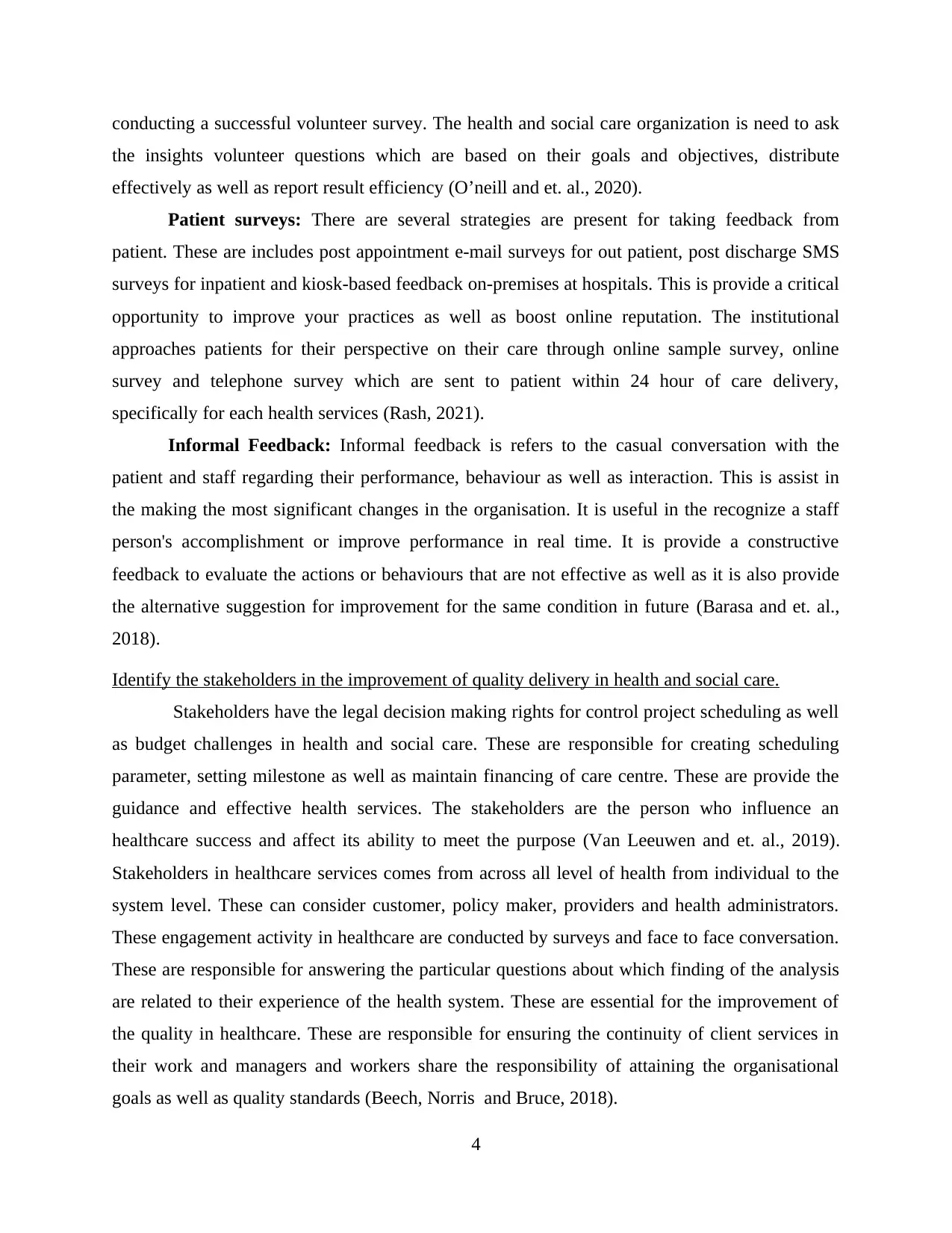
conducting a successful volunteer survey. The health and social care organization is need to ask
the insights volunteer questions which are based on their goals and objectives, distribute
effectively as well as report result efficiency (O’neill and et. al., 2020).
Patient surveys: There are several strategies are present for taking feedback from
patient. These are includes post appointment e-mail surveys for out patient, post discharge SMS
surveys for inpatient and kiosk-based feedback on-premises at hospitals. This is provide a critical
opportunity to improve your practices as well as boost online reputation. The institutional
approaches patients for their perspective on their care through online sample survey, online
survey and telephone survey which are sent to patient within 24 hour of care delivery,
specifically for each health services (Rash, 2021).
Informal Feedback: Informal feedback is refers to the casual conversation with the
patient and staff regarding their performance, behaviour as well as interaction. This is assist in
the making the most significant changes in the organisation. It is useful in the recognize a staff
person's accomplishment or improve performance in real time. It is provide a constructive
feedback to evaluate the actions or behaviours that are not effective as well as it is also provide
the alternative suggestion for improvement for the same condition in future (Barasa and et. al.,
2018).
Identify the stakeholders in the improvement of quality delivery in health and social care.
Stakeholders have the legal decision making rights for control project scheduling as well
as budget challenges in health and social care. These are responsible for creating scheduling
parameter, setting milestone as well as maintain financing of care centre. These are provide the
guidance and effective health services. The stakeholders are the person who influence an
healthcare success and affect its ability to meet the purpose (Van Leeuwen and et. al., 2019).
Stakeholders in healthcare services comes from across all level of health from individual to the
system level. These can consider customer, policy maker, providers and health administrators.
These engagement activity in healthcare are conducted by surveys and face to face conversation.
These are responsible for answering the particular questions about which finding of the analysis
are related to their experience of the health system. These are essential for the improvement of
the quality in healthcare. These are responsible for ensuring the continuity of client services in
their work and managers and workers share the responsibility of attaining the organisational
goals as well as quality standards (Beech, Norris and Bruce, 2018).
4
the insights volunteer questions which are based on their goals and objectives, distribute
effectively as well as report result efficiency (O’neill and et. al., 2020).
Patient surveys: There are several strategies are present for taking feedback from
patient. These are includes post appointment e-mail surveys for out patient, post discharge SMS
surveys for inpatient and kiosk-based feedback on-premises at hospitals. This is provide a critical
opportunity to improve your practices as well as boost online reputation. The institutional
approaches patients for their perspective on their care through online sample survey, online
survey and telephone survey which are sent to patient within 24 hour of care delivery,
specifically for each health services (Rash, 2021).
Informal Feedback: Informal feedback is refers to the casual conversation with the
patient and staff regarding their performance, behaviour as well as interaction. This is assist in
the making the most significant changes in the organisation. It is useful in the recognize a staff
person's accomplishment or improve performance in real time. It is provide a constructive
feedback to evaluate the actions or behaviours that are not effective as well as it is also provide
the alternative suggestion for improvement for the same condition in future (Barasa and et. al.,
2018).
Identify the stakeholders in the improvement of quality delivery in health and social care.
Stakeholders have the legal decision making rights for control project scheduling as well
as budget challenges in health and social care. These are responsible for creating scheduling
parameter, setting milestone as well as maintain financing of care centre. These are provide the
guidance and effective health services. The stakeholders are the person who influence an
healthcare success and affect its ability to meet the purpose (Van Leeuwen and et. al., 2019).
Stakeholders in healthcare services comes from across all level of health from individual to the
system level. These can consider customer, policy maker, providers and health administrators.
These engagement activity in healthcare are conducted by surveys and face to face conversation.
These are responsible for answering the particular questions about which finding of the analysis
are related to their experience of the health system. These are essential for the improvement of
the quality in healthcare. These are responsible for ensuring the continuity of client services in
their work and managers and workers share the responsibility of attaining the organisational
goals as well as quality standards (Beech, Norris and Bruce, 2018).
4
⊘ This is a preview!⊘
Do you want full access?
Subscribe today to unlock all pages.

Trusted by 1+ million students worldwide
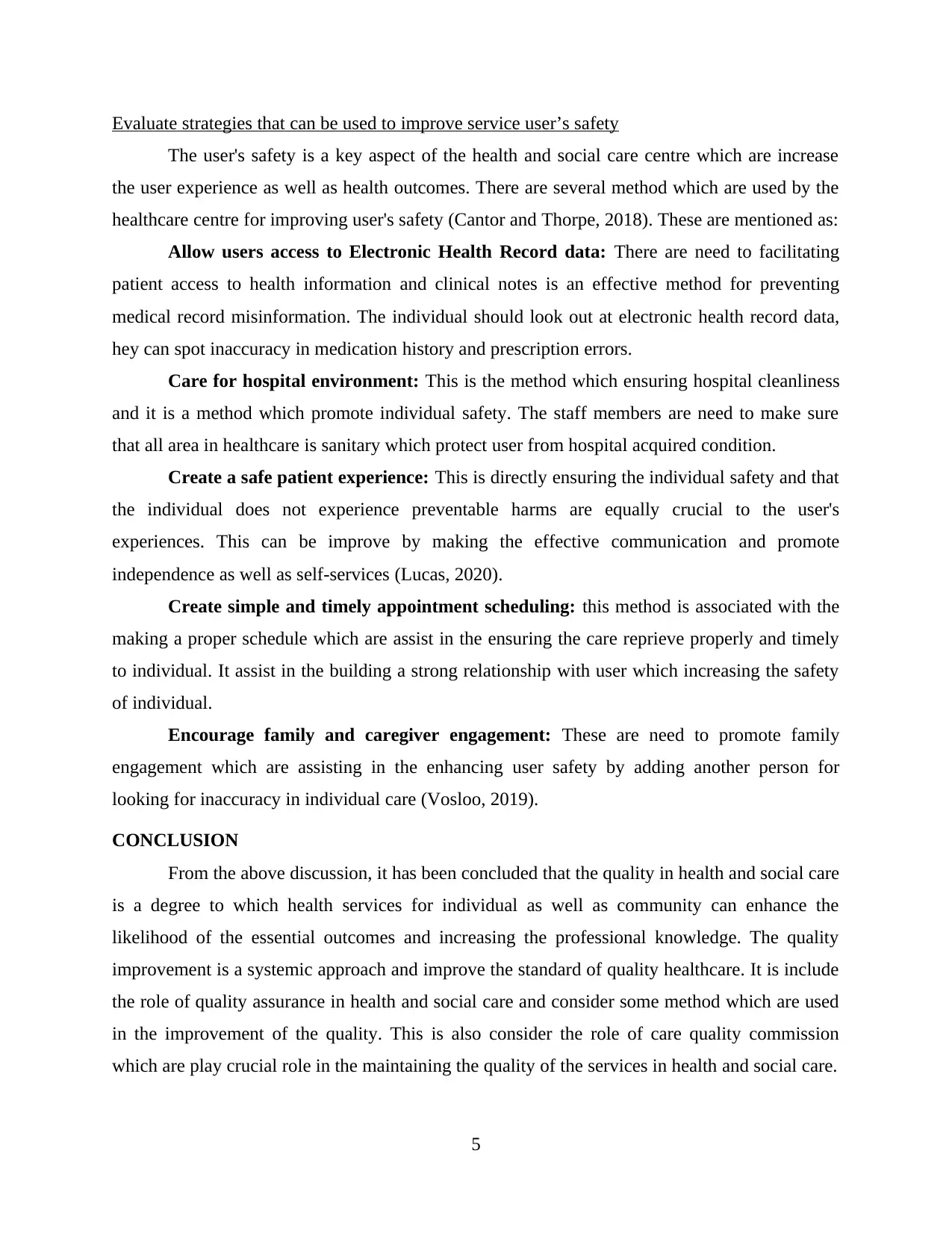
Evaluate strategies that can be used to improve service user’s safety
The user's safety is a key aspect of the health and social care centre which are increase
the user experience as well as health outcomes. There are several method which are used by the
healthcare centre for improving user's safety (Cantor and Thorpe, 2018). These are mentioned as:
Allow users access to Electronic Health Record data: There are need to facilitating
patient access to health information and clinical notes is an effective method for preventing
medical record misinformation. The individual should look out at electronic health record data,
hey can spot inaccuracy in medication history and prescription errors.
Care for hospital environment: This is the method which ensuring hospital cleanliness
and it is a method which promote individual safety. The staff members are need to make sure
that all area in healthcare is sanitary which protect user from hospital acquired condition.
Create a safe patient experience: This is directly ensuring the individual safety and that
the individual does not experience preventable harms are equally crucial to the user's
experiences. This can be improve by making the effective communication and promote
independence as well as self-services (Lucas, 2020).
Create simple and timely appointment scheduling: this method is associated with the
making a proper schedule which are assist in the ensuring the care reprieve properly and timely
to individual. It assist in the building a strong relationship with user which increasing the safety
of individual.
Encourage family and caregiver engagement: These are need to promote family
engagement which are assisting in the enhancing user safety by adding another person for
looking for inaccuracy in individual care (Vosloo, 2019).
CONCLUSION
From the above discussion, it has been concluded that the quality in health and social care
is a degree to which health services for individual as well as community can enhance the
likelihood of the essential outcomes and increasing the professional knowledge. The quality
improvement is a systemic approach and improve the standard of quality healthcare. It is include
the role of quality assurance in health and social care and consider some method which are used
in the improvement of the quality. This is also consider the role of care quality commission
which are play crucial role in the maintaining the quality of the services in health and social care.
5
The user's safety is a key aspect of the health and social care centre which are increase
the user experience as well as health outcomes. There are several method which are used by the
healthcare centre for improving user's safety (Cantor and Thorpe, 2018). These are mentioned as:
Allow users access to Electronic Health Record data: There are need to facilitating
patient access to health information and clinical notes is an effective method for preventing
medical record misinformation. The individual should look out at electronic health record data,
hey can spot inaccuracy in medication history and prescription errors.
Care for hospital environment: This is the method which ensuring hospital cleanliness
and it is a method which promote individual safety. The staff members are need to make sure
that all area in healthcare is sanitary which protect user from hospital acquired condition.
Create a safe patient experience: This is directly ensuring the individual safety and that
the individual does not experience preventable harms are equally crucial to the user's
experiences. This can be improve by making the effective communication and promote
independence as well as self-services (Lucas, 2020).
Create simple and timely appointment scheduling: this method is associated with the
making a proper schedule which are assist in the ensuring the care reprieve properly and timely
to individual. It assist in the building a strong relationship with user which increasing the safety
of individual.
Encourage family and caregiver engagement: These are need to promote family
engagement which are assisting in the enhancing user safety by adding another person for
looking for inaccuracy in individual care (Vosloo, 2019).
CONCLUSION
From the above discussion, it has been concluded that the quality in health and social care
is a degree to which health services for individual as well as community can enhance the
likelihood of the essential outcomes and increasing the professional knowledge. The quality
improvement is a systemic approach and improve the standard of quality healthcare. It is include
the role of quality assurance in health and social care and consider some method which are used
in the improvement of the quality. This is also consider the role of care quality commission
which are play crucial role in the maintaining the quality of the services in health and social care.
5
Paraphrase This Document
Need a fresh take? Get an instant paraphrase of this document with our AI Paraphraser
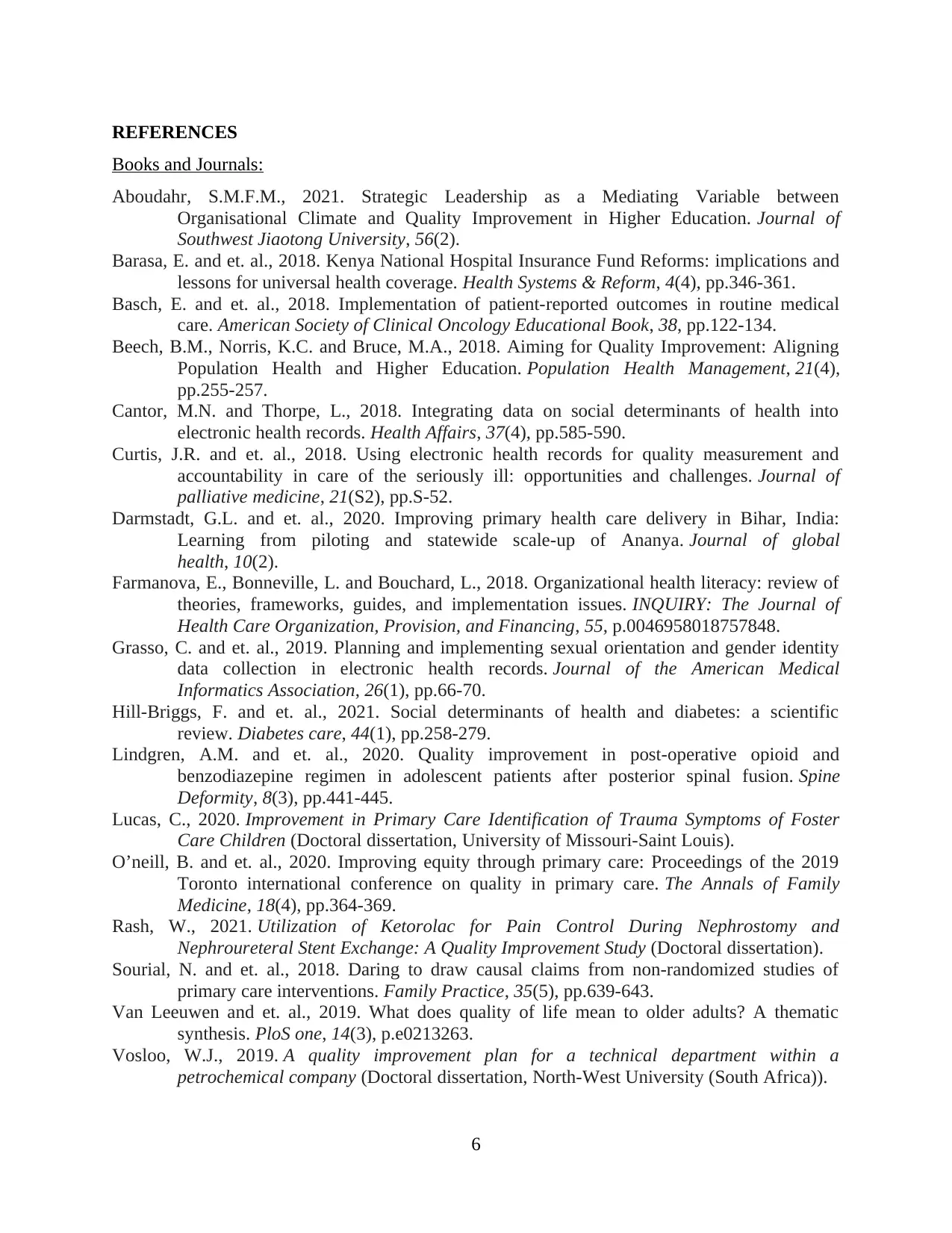
REFERENCES
Books and Journals:
Aboudahr, S.M.F.M., 2021. Strategic Leadership as a Mediating Variable between
Organisational Climate and Quality Improvement in Higher Education. Journal of
Southwest Jiaotong University, 56(2).
Barasa, E. and et. al., 2018. Kenya National Hospital Insurance Fund Reforms: implications and
lessons for universal health coverage. Health Systems & Reform, 4(4), pp.346-361.
Basch, E. and et. al., 2018. Implementation of patient-reported outcomes in routine medical
care. American Society of Clinical Oncology Educational Book, 38, pp.122-134.
Beech, B.M., Norris, K.C. and Bruce, M.A., 2018. Aiming for Quality Improvement: Aligning
Population Health and Higher Education. Population Health Management, 21(4),
pp.255-257.
Cantor, M.N. and Thorpe, L., 2018. Integrating data on social determinants of health into
electronic health records. Health Affairs, 37(4), pp.585-590.
Curtis, J.R. and et. al., 2018. Using electronic health records for quality measurement and
accountability in care of the seriously ill: opportunities and challenges. Journal of
palliative medicine, 21(S2), pp.S-52.
Darmstadt, G.L. and et. al., 2020. Improving primary health care delivery in Bihar, India:
Learning from piloting and statewide scale-up of Ananya. Journal of global
health, 10(2).
Farmanova, E., Bonneville, L. and Bouchard, L., 2018. Organizational health literacy: review of
theories, frameworks, guides, and implementation issues. INQUIRY: The Journal of
Health Care Organization, Provision, and Financing, 55, p.0046958018757848.
Grasso, C. and et. al., 2019. Planning and implementing sexual orientation and gender identity
data collection in electronic health records. Journal of the American Medical
Informatics Association, 26(1), pp.66-70.
Hill-Briggs, F. and et. al., 2021. Social determinants of health and diabetes: a scientific
review. Diabetes care, 44(1), pp.258-279.
Lindgren, A.M. and et. al., 2020. Quality improvement in post-operative opioid and
benzodiazepine regimen in adolescent patients after posterior spinal fusion. Spine
Deformity, 8(3), pp.441-445.
Lucas, C., 2020. Improvement in Primary Care Identification of Trauma Symptoms of Foster
Care Children (Doctoral dissertation, University of Missouri-Saint Louis).
O’neill, B. and et. al., 2020. Improving equity through primary care: Proceedings of the 2019
Toronto international conference on quality in primary care. The Annals of Family
Medicine, 18(4), pp.364-369.
Rash, W., 2021. Utilization of Ketorolac for Pain Control During Nephrostomy and
Nephroureteral Stent Exchange: A Quality Improvement Study (Doctoral dissertation).
Sourial, N. and et. al., 2018. Daring to draw causal claims from non-randomized studies of
primary care interventions. Family Practice, 35(5), pp.639-643.
Van Leeuwen and et. al., 2019. What does quality of life mean to older adults? A thematic
synthesis. PloS one, 14(3), p.e0213263.
Vosloo, W.J., 2019. A quality improvement plan for a technical department within a
petrochemical company (Doctoral dissertation, North-West University (South Africa)).
6
Books and Journals:
Aboudahr, S.M.F.M., 2021. Strategic Leadership as a Mediating Variable between
Organisational Climate and Quality Improvement in Higher Education. Journal of
Southwest Jiaotong University, 56(2).
Barasa, E. and et. al., 2018. Kenya National Hospital Insurance Fund Reforms: implications and
lessons for universal health coverage. Health Systems & Reform, 4(4), pp.346-361.
Basch, E. and et. al., 2018. Implementation of patient-reported outcomes in routine medical
care. American Society of Clinical Oncology Educational Book, 38, pp.122-134.
Beech, B.M., Norris, K.C. and Bruce, M.A., 2018. Aiming for Quality Improvement: Aligning
Population Health and Higher Education. Population Health Management, 21(4),
pp.255-257.
Cantor, M.N. and Thorpe, L., 2018. Integrating data on social determinants of health into
electronic health records. Health Affairs, 37(4), pp.585-590.
Curtis, J.R. and et. al., 2018. Using electronic health records for quality measurement and
accountability in care of the seriously ill: opportunities and challenges. Journal of
palliative medicine, 21(S2), pp.S-52.
Darmstadt, G.L. and et. al., 2020. Improving primary health care delivery in Bihar, India:
Learning from piloting and statewide scale-up of Ananya. Journal of global
health, 10(2).
Farmanova, E., Bonneville, L. and Bouchard, L., 2018. Organizational health literacy: review of
theories, frameworks, guides, and implementation issues. INQUIRY: The Journal of
Health Care Organization, Provision, and Financing, 55, p.0046958018757848.
Grasso, C. and et. al., 2019. Planning and implementing sexual orientation and gender identity
data collection in electronic health records. Journal of the American Medical
Informatics Association, 26(1), pp.66-70.
Hill-Briggs, F. and et. al., 2021. Social determinants of health and diabetes: a scientific
review. Diabetes care, 44(1), pp.258-279.
Lindgren, A.M. and et. al., 2020. Quality improvement in post-operative opioid and
benzodiazepine regimen in adolescent patients after posterior spinal fusion. Spine
Deformity, 8(3), pp.441-445.
Lucas, C., 2020. Improvement in Primary Care Identification of Trauma Symptoms of Foster
Care Children (Doctoral dissertation, University of Missouri-Saint Louis).
O’neill, B. and et. al., 2020. Improving equity through primary care: Proceedings of the 2019
Toronto international conference on quality in primary care. The Annals of Family
Medicine, 18(4), pp.364-369.
Rash, W., 2021. Utilization of Ketorolac for Pain Control During Nephrostomy and
Nephroureteral Stent Exchange: A Quality Improvement Study (Doctoral dissertation).
Sourial, N. and et. al., 2018. Daring to draw causal claims from non-randomized studies of
primary care interventions. Family Practice, 35(5), pp.639-643.
Van Leeuwen and et. al., 2019. What does quality of life mean to older adults? A thematic
synthesis. PloS one, 14(3), p.e0213263.
Vosloo, W.J., 2019. A quality improvement plan for a technical department within a
petrochemical company (Doctoral dissertation, North-West University (South Africa)).
6
1 out of 8
Related Documents
Your All-in-One AI-Powered Toolkit for Academic Success.
+13062052269
info@desklib.com
Available 24*7 on WhatsApp / Email
![[object Object]](/_next/static/media/star-bottom.7253800d.svg)
Unlock your academic potential
Copyright © 2020–2025 A2Z Services. All Rights Reserved. Developed and managed by ZUCOL.





